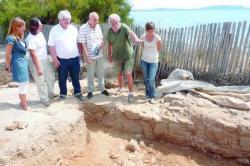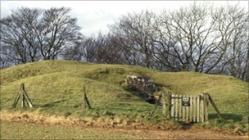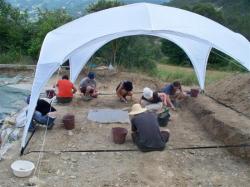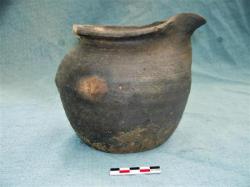- 09 AOÛT
- INDI-UNI : 
PRE-INSCRIPTION : 15 Juin – 15 Août
PRE-REGISTRATION: June 15th - August 15th
- IRLANDE – Clonmany - An ancient underground chamber which could date back 2,000 years has been unearthed near Clonmany in Inishowen. Discovered by Clonmany man Sean Devlin, the previously unrecorded structure appears to be an underground tunnel or souterrain. Mr Devlin revealed yesterday that he first discovered the underground chamber several years ago while landscaping his front garden, but didn’t make much of a fuss about his amazing find at the time. The historic significance of the tunnel only became apparent recently after Mr Devlin showed it to amateur archaeologist friends. Souterrains are underground man-made drystone built structures roofed with large lintels, comprising of one or more chambers linked by tunnels called creepways. Their entrance is concealed at ground level. They are usually found in locations near to ringforts, cashels and early ecclesiastical sites. Interestingly, Clonmany means ‘the meadow of the monks’. Derry man and long time amateur archaeologist Eddie Harkin, who visited and examined this fascinating structure with colleagues Tommy Gallagher and Brian MacNeachtain, confirmed that it has at least three chambers with a creepway linking each one. In one chamber Mr Harkin says there is a quantity of bones - which may or may not be human - deposited in niches along one side of the souterrain wall. He also found part of a quern stone as well as a quantity of shells. According to Mr Harkin, archaeologists believe that sounterrains were used as places of refuge, as many of them have defensive features such as low set lintels built into their roofs. They may have also been used for storing food. Indeed, it is possible that this souterrain continues and may be connected to the sixth century monastic site across the road.
http://www.derryjournal.com/news/local/ancient_stone_chamber_unearthed_in_garden_1_2128768
- FRANCE –  Olbia - Après une première vague de fouilles, à l'été 2010, Michel Bats, qui dirige les travaux de recherche, et son équipe de bénévoles, à savoir 17 étudiants en archéologie venus de toute la France, ont repris du service au mois de juillet. Le site Olbia avait déjà révélé pas mal de ses secrets l'an dernier, notamment dans la zone située en dehors du périmètre ouvert au public, à deux pas de la plage de l'Almanarre, entre le bord de mer et la route départementale 559. Le sol avait en effet été sondé, et un rempart d'îlots grecs ainsi que des thermes romains avaient été mis à jour. Ce mois-ci, à force de « gratter » la terre antique huit heures par jour, l'équipe d'archéologues a fini de dégager le rempart, dont le tracé est régulièrement interrompu par des aménagements liés aux thermes. L'extrémité d'un bassin recouvert d'un enduit hydraulique peint, et un réseau de canalisations complètent aussi, à présent, le plan de ces fameux thermes. Du « mobilier » , c'est-à-dire de la poterie et de la céramique, a également été trouvé durant les fouilles, qui, après avoir été trié, lavé, etc, précisera les datations des ensembles architecturaux. D'ores et déjà, Michel Bats est capable d'en dire beaucoup : « Une ville a été construite, comme un carré, le long du bord de mer, à la fin du IVesiècle avant J-C. Puis, après un effondrement, il y a eu une reconstruction deux siècles plus tard. Enfin, dans la première moitié du Iersiècle après JC, une grande terrasse a été construite, qui avançait sur la mer, et sur laquelle a été implanté un établissement thermal, sous l'égide d'un"grand personnage". » Le scientifique poursuit : « Cet établissement, qui abritait sans doute aussi des bains thérapeutiques, était destiné à accueillir les invités de ce personnage, mais également, déjà, des touristes. C'est quelque chose d'unique sur le littoral méditerranéen. » Il est encore établi que « dans l'îlot fouillé, il y avait un marchand de vin, et d'autres boutiques. »
Olbia - Après une première vague de fouilles, à l'été 2010, Michel Bats, qui dirige les travaux de recherche, et son équipe de bénévoles, à savoir 17 étudiants en archéologie venus de toute la France, ont repris du service au mois de juillet. Le site Olbia avait déjà révélé pas mal de ses secrets l'an dernier, notamment dans la zone située en dehors du périmètre ouvert au public, à deux pas de la plage de l'Almanarre, entre le bord de mer et la route départementale 559. Le sol avait en effet été sondé, et un rempart d'îlots grecs ainsi que des thermes romains avaient été mis à jour. Ce mois-ci, à force de « gratter » la terre antique huit heures par jour, l'équipe d'archéologues a fini de dégager le rempart, dont le tracé est régulièrement interrompu par des aménagements liés aux thermes. L'extrémité d'un bassin recouvert d'un enduit hydraulique peint, et un réseau de canalisations complètent aussi, à présent, le plan de ces fameux thermes. Du « mobilier » , c'est-à-dire de la poterie et de la céramique, a également été trouvé durant les fouilles, qui, après avoir été trié, lavé, etc, précisera les datations des ensembles architecturaux. D'ores et déjà, Michel Bats est capable d'en dire beaucoup : « Une ville a été construite, comme un carré, le long du bord de mer, à la fin du IVesiècle avant J-C. Puis, après un effondrement, il y a eu une reconstruction deux siècles plus tard. Enfin, dans la première moitié du Iersiècle après JC, une grande terrasse a été construite, qui avançait sur la mer, et sur laquelle a été implanté un établissement thermal, sous l'égide d'un"grand personnage". » Le scientifique poursuit : « Cet établissement, qui abritait sans doute aussi des bains thérapeutiques, était destiné à accueillir les invités de ce personnage, mais également, déjà, des touristes. C'est quelque chose d'unique sur le littoral méditerranéen. » Il est encore établi que « dans l'îlot fouillé, il y avait un marchand de vin, et d'autres boutiques. »
http://www.varmatin.com/article/archeologie-a-olbia-les-fouilles-continuent-de-reveler-leurs-secrets
- ROYAUME UNI –  Uley Long Barrow - An ancient burial site which dates back thousands of years has been reopened to the public after two years of repairs. Uley Long Barrow in Gloucestershire, known as Hetty Pegler's Tump, was closed while urgent structural work was carried out at the Neolithic site. Structural damage to the interior dry stone walls of the burial chamber had left it in an unsafe condition. English Heritage has overseen the work to restore the 120ft (37m) long monument which dates back to 3200BC. The archaeological investigations carried out during the urgent works by the Cotswold Archaeology team have also confirmed the original plan of the burial chambers which were excavated in both 1821 and in 1854. Samples of original Neolithic mound material will now be taken away for analysis in a bid to establish a more accurate date. The scheduled monument is managed by Gloucestershire County Council on behalf of English Heritage and is named after Hester Pegler, the 17th century owner of the field in which it sits.It is one of a series of ancient stone structures known as the Cotswold-Severn barrow group, sited near Dursley and overlooking the Severn Valley. Very little is known about who was buried there other than that they were from some of the first settled farming communities.
Uley Long Barrow - An ancient burial site which dates back thousands of years has been reopened to the public after two years of repairs. Uley Long Barrow in Gloucestershire, known as Hetty Pegler's Tump, was closed while urgent structural work was carried out at the Neolithic site. Structural damage to the interior dry stone walls of the burial chamber had left it in an unsafe condition. English Heritage has overseen the work to restore the 120ft (37m) long monument which dates back to 3200BC. The archaeological investigations carried out during the urgent works by the Cotswold Archaeology team have also confirmed the original plan of the burial chambers which were excavated in both 1821 and in 1854. Samples of original Neolithic mound material will now be taken away for analysis in a bid to establish a more accurate date. The scheduled monument is managed by Gloucestershire County Council on behalf of English Heritage and is named after Hester Pegler, the 17th century owner of the field in which it sits.It is one of a series of ancient stone structures known as the Cotswold-Severn barrow group, sited near Dursley and overlooking the Severn Valley. Very little is known about who was buried there other than that they were from some of the first settled farming communities.
http://www.bbc.co.uk/news/uk-england-gloucestershire-14442631
- ROYAUME UNI – Morpeth - A centuries old link to Morpeth’s past has been discovered high in the Cheviot hills. Coquetdale Community Archaeology (CCA) has completed a ten-day dig on the River Coquet to explore the remains of a medieval fulling mill. Records from Newminster Abbey in Morpeth show that its monks built a mill along that stretch of river. Last summer masonry blocks and timber were found, and carbon dating has revealed they are about 800 years old. More than 30 people have been working to expose more masonry and have revealed the wheel pit for the mill, as well as a large wooden structure upstream, which is thought to be the remains of a system of sluices.
http://www.morpethherald.co.uk/lifestyle/historic_link_uncovered_1_3646132
- VIET-NAM – Ho - The Center for Preservation of Ho Citadel has discovered the place believed to be the quarry that provided the material to build the Ho Citadel, a world cultural heritage recognized by the UNESCO in the central province of Thanh Hoa. The quarry is located in Phu Luu village, Vinh Yen commune, Vinh Loc district, around 2km to the northeast of the relic. The centre has unearthed 21 flagstones scattered across a wide area. Based on cutting marks on the surface of the stones and comparisons with stones from the citadel, experts said that the stones were intended for the citadel but discarded because of faults such as cracks and size. “Analysis shows that these are rocks that were processed to build the Ho citadel,” Dr. Tong Trung Tin, director of the Vietnam Archaeology Institute, says. Scientists will continue their research to know how these big rocks were transported to the Ho citadel. Some scientists say that perhaps builders used waterway or balls to carry the rock to the construction site. The citadel was built under the reign of King Ho Quy Ly and became the capital of Vietnam from 1397 to 1407. According to estimations, about 25,000cu.m of stone was used to build the walls of the citadel, and each stone had an average weight of 10-20 tonnes. On account of its unique architectural and historical values, it was recognised as a World Culture Heritage by UNESCO on June 27, 2011.
http://english.vietnamnet.vn/en/arts-entertainment/11711/source-of-rock-for-building-ancient-ho-citadel-discovered.html
- FRANCE – 
 Clos de l’Aure - Les fouilles archéologiques au Clos de l’Aure ont commencé il y a 11 ans et depuis le début, Marie-Pierre Estienne, chargée de recherche et spécialiste du Moyen Âge, a été passionnée par cette découverte due en partie au hasard. En 2001, une opération de sauvetage et de diagnostique archéologique a été programmée à la suite de la découverte, par hasard, d’une église du 11 e siècle masquée par un pierrier. Cette église mériterait à elle seule une conservation et une mise en valeur. En 2007, un bassin datant des premiers temps chrétiens des 5 e et 6 e siècles après Jésus-Christ, a été découvert avec ses surverses en terre cuite, son espace domestique comprenant des déchets alimentaires dont de très nombreux coquillages et à proximité des fragments de grandes coupes de verres et des fragments de céramique de la même époque. La campagne 2009 confirme, elle, la présence dès l’antiquité tardive, d’un bâtiment domestique de construction soignée qui abrite un bassin puis un deuxième pouvant faire partie de thermes privés au vu de la présence d’hypocauste (chauffage au sol) datant du 5 e siècle et encore occupé au 6 e siècle avant la transformation de cette zone en cimetière dès le 9 e siècle. Cette année, les fouilles ont commencé début juillet et les découvertes ont été multiples. Une poterie pégau en céramique du 12 e siècle a été trouvée dans une tombe. Elle devait contenir soit de l’eau bénite, soit des cendres et ce afin d’accompagner la personne défunte dans l’au-delà. Autre surprise : la découverte des squelettes d’un homme et de deux femmes d’un certain âge. D’après Sylvie Bailbourdian, anthropologue du laboratoire UMR du CNRS de la faculté de Marseille, l’un d’entre eux avait dû souffrir d’arthrose du temps de son vivant. Trois pièces nouvelles ont été mises au jour ainsi que des morceaux de verre devant appartenir aux thermes. Pour le côté médiéval une serrure métallique et des fragments de marmites datant du 14 e siècle ont été trouvés.
Clos de l’Aure - Les fouilles archéologiques au Clos de l’Aure ont commencé il y a 11 ans et depuis le début, Marie-Pierre Estienne, chargée de recherche et spécialiste du Moyen Âge, a été passionnée par cette découverte due en partie au hasard. En 2001, une opération de sauvetage et de diagnostique archéologique a été programmée à la suite de la découverte, par hasard, d’une église du 11 e siècle masquée par un pierrier. Cette église mériterait à elle seule une conservation et une mise en valeur. En 2007, un bassin datant des premiers temps chrétiens des 5 e et 6 e siècles après Jésus-Christ, a été découvert avec ses surverses en terre cuite, son espace domestique comprenant des déchets alimentaires dont de très nombreux coquillages et à proximité des fragments de grandes coupes de verres et des fragments de céramique de la même époque. La campagne 2009 confirme, elle, la présence dès l’antiquité tardive, d’un bâtiment domestique de construction soignée qui abrite un bassin puis un deuxième pouvant faire partie de thermes privés au vu de la présence d’hypocauste (chauffage au sol) datant du 5 e siècle et encore occupé au 6 e siècle avant la transformation de cette zone en cimetière dès le 9 e siècle. Cette année, les fouilles ont commencé début juillet et les découvertes ont été multiples. Une poterie pégau en céramique du 12 e siècle a été trouvée dans une tombe. Elle devait contenir soit de l’eau bénite, soit des cendres et ce afin d’accompagner la personne défunte dans l’au-delà. Autre surprise : la découverte des squelettes d’un homme et de deux femmes d’un certain âge. D’après Sylvie Bailbourdian, anthropologue du laboratoire UMR du CNRS de la faculté de Marseille, l’un d’entre eux avait dû souffrir d’arthrose du temps de son vivant. Trois pièces nouvelles ont été mises au jour ainsi que des morceaux de verre devant appartenir aux thermes. Pour le côté médiéval une serrure métallique et des fragments de marmites datant du 14 e siècle ont été trouvés.
http://www.ledauphine.com/hautes-alpes/2011/08/07/trois-squelettes-ont-ete-decouverts-cet-ete